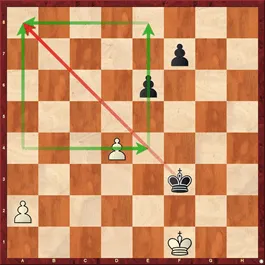Chess is a game of strategy. Every move matters. In endgames, tempo becomes very important. But what is tempo in chess?
What is Tempo?
Tempo is a move or turn. In chess, it is a single move by one player. Gaining tempo means forcing your opponent to waste a move. Losing tempo means wasting a move yourself.
Why Is Tempo Important?
Tempo can decide the game in endgames. In endgames, both players have fewer pieces. Each move can be critical. Gaining or losing tempo can change the game’s outcome.

Credit: thechessworld.com

Credit: chess-teacher.com
How to Use Tempo in Endgames
There are several ways to use tempo in endgames. Here are some key methods:
Zugzwang
Zugzwang is a German word. It means “compulsion to move.” In chess, it means a player is forced to make a move. Any move they make will worsen their position. Putting your opponent in zugzwang can give you a big advantage.
Waiting Moves
Sometimes, you need to wait. A waiting move is a move that does not change the position. It forces your opponent to make a move. This can give you the upper hand.
Opposition
Opposition is a key concept in king and pawn endgames. It means placing your king directly opposite your opponent’s king. This can control key squares and force your opponent to move their king away.
Examples of Tempo in Endgames
Let’s look at some examples. These will show how tempo works in real games.
Example 1: King And Pawn Endgame
Imagine you have a king and a pawn. Your opponent has only a king. Your goal is to promote your pawn to a queen. Here, tempo is very important.
First, you must use your king to support your pawn. Move your king to control key squares. Force your opponent’s king to move away. This will allow your pawn to advance.
Example 2: Rook Endgame
In rook endgames, tempo can be used to control key squares. For example, you might use your rook to cut off your opponent’s king. This can force your opponent to move their king to a worse position.
Example 3: Bishop And Pawn Endgame
In bishop and pawn endgames, tempo can be used to control diagonals. Move your bishop to control key diagonals. Force your opponent’s king to move away. This can allow your pawn to advance.
Common Mistakes with Tempo
Many players make mistakes with tempo. Here are some common mistakes:
Wasting Tempo
Wasting tempo means making moves that do not improve your position. Avoid making unnecessary moves. Every move should have a purpose.
Ignoring Zugzwang
Ignoring zugzwang can be a big mistake. Always look for ways to put your opponent in zugzwang. This can give you a big advantage.
Not Using Opposition
Not using opposition can be a costly mistake. Always look for ways to use opposition in king and pawn endgames. This can control key squares and force your opponent to move away.
How to Improve Your Tempo Skills
Improving your tempo skills can help you win more games. Here are some tips:
Study Endgames
Study endgames to understand how tempo works. Look at examples and practice different positions. This will help you recognize key patterns.
Practice Puzzles
Practice endgame puzzles to improve your tempo skills. Puzzles can help you recognize key moves and improve your calculation skills.
Play Endgame Positions
Play endgame positions to practice your tempo skills. Set up different positions and play them out. This will help you understand how tempo works in real games.
Conclusion
Tempo is very important in chess endgames. It can decide the game’s outcome. By understanding and using tempo, you can gain a big advantage. Study endgames, practice puzzles, and play positions to improve your tempo skills. This will help you win more games.







